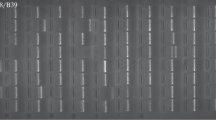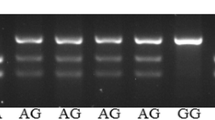Abstract
Based on the reports, few HLA class II alleles are associated with susceptibility or protection in breast cancer. Here we investigate the association between HLA class II alleles and breast cancer in Iranian women. 100 patients with pathologically proven breast cancer who referred to Cancer Institute were randomly selected and compared with a group of 80 healthy blood donor subjects. The patients were studied in two groups, group 1 includes patients aging 40 years or younger and group 2 include patients aging over 40 years. HLA class II alleles were determined by amplification of DNA followed by HLA-typing using sequence-specific primer (SSP) for each allele. In group 1, the most frequent alleles were HLA-DQA1*0301 (P = 0.002, OR = 3.3) and HLA-DQB1*0302 (P = 0.04, OR = 2.8). In group 2, the following alleles increased significantly than those in controls including HLA-DQA1*0301 (P = 0.001, OR = 3.4) and HLA-DRB1*0301 (P = 0.04, OR = 2.3). In complete group of patients, the frequency of HLA-DQA1*0301 (P = 0.001, OR = 3.4) and HLA-DRB1*1303 (P = 0.02, OR = 2.3) increased significantly than those in control group. HLA-DQA1*0505, HLA-DQA1*0101, HLA-DRB1*1301and HLA-DRB1*0101 alleles showed negative association with breast cancer. Our findings suggest that HLA-DQA1*0301 allele is mainly associated with increased risk of breast cancer including early-onset of the disease. HLA-DQA1*0505 and HLA-DRB1*1301 are involved in protection. We conclude that specific alleles of HLA class II influence breast cancer risk.
Similar content being viewed by others
References
Parkin DM, Bray F, Ferlay J et al (2005) Global cancer statistics, 2002. CA Cancer J Clin 55(2):74–108
Forbes JF (1997) The incidence of breast cancer: the global burden, public health considerations. Semin Oncol 24(Suppl 1):S1-20–S1-35
de Jong MM, Nolte IM, te Meerman GJ et al (2002) Genes other than BRCA1 and BRCA2 involved in breast cancer susceptibility. J Med Genet 39(4):225–242
Futreal PA, Liu Q, Shattuck-Eidens D et al (1994) BRCA1 mutations in primary breast and ovarian carcinomas. Science 7(266(5182)):120–122
Pistillo MP, Nicolò G, Salvi S et al (2000) Biochemical analysis of HLA class I subunits expression in breast cancer tissues. Hum Immunol 61:397–407
Salih HR, Nussler V (2001) Commentary: immune escape versus tumor tolerance: how do tumors evade immune surveillance? Eur J Med Res 6:323–332
Dunn GP, Bruce AT, Ikeda H et al (2002) Cancer immunoediting: from immunosurveillance to tumor escape. Nat Immunol 3:991–998
Forbes SA, Trowsdale J (1997) The MHC quarterly report. Immunogenetics 50:152–159
Hosono S, Kawase T, Matsuo K et al (2010) HLA-A alleles and the risk of cervical squamous cell carcinoma in Japanese women. J Epidemiol 20(4):295–301
Castro FA, Haimila K, Sareneva I et al (2009) Association of HLA-DRB1, interleukin-6 and cyclin D1 polymorphisms with cervical cancer in the Swedish population–a candidate gene approach. Int J Cancer 125(8):1851–1858
Lee HW, Hahm KB, Lee JS et al (2009) Association of the human leukocyte antigen class II alleles with chronic atrophic gastritis and gastric carcinoma in Koreans. J Dig Dis 10(4):265–271
Ishigami S, Natsugoe S, Nakajo A et al (2008) HLA-class I expression in gastric cancer. J Surg Oncol 97(7):605–608
Gamzatova Z, Villabona L, van der Zanden H et al (2007) Analysis of HLA class I-II haplotype frequency and segregation in a cohort of patients with advanced stage ovarian cancer. Tissue Antigens 70(3):205–213
Gogas H, Kirkwood JM, Falk CS et al (2010) Correlation of molecular human leukocyte antigen typing and outcome in high-risk melanoma patients receiving adjuvant interferon. Cancer 116(18):4326–4333
Chaudhuri S, Cariappa A, Tang M et al (2000) Genetic susceptibility to breast cancer: HLA DQB*03032 and HLA DRB1*11 may represent protective alleles. Proc Natl Acad Sci U S A 97(21):11451–11454
Ghaderi A, Talei A, Gharesi-Fard B et al (2001) HLA-DRB1 alleles and the susceptibility of Iranian patients with breast cancer. Pathol Oncol Res 7:39–41
Lavado R, Benavides M, Villar E et al (2005) The HLA-B7 allele confers susceptibility to breast cancer in Spanish women. Immunol Lett 101(2):223–225
Cantú de León D, Pérez-Montiel D, Villavicencio V et al (2009) High resolution human leukocyte antigen (HLA) class I and class II allele typing in Mexican mestizo women with sporadic breast cancer: case-control study. BMC Cancer 9:48
Miller SA, Dykes DD, Polesky HE (1989) A simple salting out procedure for extracting DNA from human nucleated cells. Nucleic Acids Res 16:1215–1221
Amirzargar AA, Khosravi F, Dianat SS et al (2007) Association of HLA class II allele and haplotype frequencies with chronic myelogenous leukemia and age-at-onset of the disease. Pathol Oncol Res 13(1):47–51
Olerup O, Zetterquist H (1992) HLA-DR typing by PCR amplification with sequence-specific primers (PCR-SSP) in 2 hours: an alternative to serological DR typing in clinical practice including donor-recipient matching in cadaveric transplantation. Tissue Antigens 39:225–235
Amirzargar A, Mytilineos J, Farjadian S et al (2001) Human leukocyte antigen class II allele frequencies and haplotype association in Iranian normal population. Hum Immunol 62:1234–1238
McPherson K, Steel CM, Dixon JM (2000) ABC of breast diseases. Breast cancer–epidemiology, risk factors and genetics. BMJ 321(7261):624–628
Ferlay J, Shin HR, Bray F et al (2010) Estimates of worldwide burden of cancer in 2008: GLOBOCAN 2008. Int J Cancer 127:2893–2917
World Cancer Report 2008. WHO, http://www.iarc.fr/en/publications/pdfsonline/wcr/2008/index.php (2 November 2010, date last accessed).
Anderson BO, Jakesz R (2008) Breast cancer issues in developing countries: an overview of the Breast Health Global Initiative. World J Surg 32:2578–2585
The Top 10 Causes of Death in 2004 (2008) Fact Sheet of WHO Report, World Health Organization.
Harirchi I, Mousavi SM, Mohagheghi MA et al (2009) Early detection for breast cancer in Iran. Asian Pac J Cancer Prev 10(5):849–851
Mousavi SM, Gouya MM, Ramazani R et al (2009) Cancer incidence and mortality in Iran. Ann Oncol 20:556–563
Baccar Harrath A, Yacoubi Loueslati B, Troudi W et al (2006) HLA class II polymorphism: protective or risk factors to breast cancer in Tunisia? Pathol Oncol Res 12(2):79–81
Ferrera A, Olivo A, Alaez C et al (1999) HLA-DOA1 and -DOB1 loci in Honduran women with cervical dysplasia and invasive cervical carcinoma and their relationship to human papillomavirus infection. Hum Biol 71(3):367–379
Acknowledgments
This research was supported by Tehran University of Medical Sciences (grant No. 4785). The authors are very grateful to all colleagues in Molecular Immunology Research Center, Tehran University of Medical Sciences for their kind help and to all the patients for their kind collaboration in this study.
Author information
Authors and Affiliations
Corresponding author
Rights and permissions
About this article
Cite this article
Mahmoodi, M., Nahvi, H., Mahmoudi, M. et al. HLA-DRB1,-DQA1 and -DQB1 Allele and Haplotype Frequencies in Female Patients with Early Onset Breast Cancer. Pathol. Oncol. Res. 18, 49–55 (2012). https://doi.org/10.1007/s12253-011-9415-6
Received:
Accepted:
Published:
Issue Date:
DOI: https://doi.org/10.1007/s12253-011-9415-6




